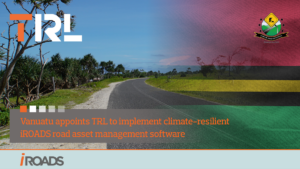Highways News spoke to Vaisala’s Head of Road Asset Management, Ben Brown about the company’s development of its RoadAI asset management system, the benefits of which are now being enjoyed by several local authorities across the UK as they look to gain more insight on the condition of their networks.
Highways News (HN): Ben, you have been involved with the development of Vaisala’s road condition surveys. Please give us an overview of what these are, why they have become important and the main benefits?
Ben Brown (BB): “RoadAI uses video collected by a smartphone, and Artificial Intelligence enabled Computer Vision processing to generate multiple data sets that can be used to inform highways maintenance decisions. This simple tool provides a way for inspectors who are already on the network to perform their tasks more safely and efficiently, and the data they record while they go about their work is then automatically processed to generate data that can support other operational teams and processes. Riding along in the vehicles of these inspectors and then producing condition and inventory data makes the initial inspection process safer and more efficient, but also takes many vehicles off the network that would otherwise be required to undertake condition surveys, traffic signs surveys, arboricultural inspections, flooding and drainage surveys.”
HN: These solutions have been quickly taken up by some local authorities in the UK-give us a brief overview of who you have been working with and how they have made best use of the system?
BB: “Vaisala are now working with a large number of Local Authorities, ranging from the South Coast to the northern Isles of Scotland. Our users have been able to achieve efficiencies across both their reactive and planned maintenance activities through one system, providing them with rich and frequently updated data. Perhaps what our users like most about RoadAI is its simplicity – whilst advanced and complex technology makes the solution possible, it is quick and easy to use and data is displayed and reported in easy to understand formats.”
HN: Tell us about the use of AI within your systems and the benefits that brings?
BB: “RoadAI leverages computer vision technology, a branch of AI concerned with the automatic identification of objects from imagery. AI is capable of providing detailed and granular information on pavement condition, by identifying the presence, extent and severity of a wide array of different defects. This data can be used to support both reactive and planned maintenance activities. In addition, AI is able to detect traffic signs, condition of line markings, and provide information on a range of other assets. The analysis undertaken by computer vision is entirely automated and doesn’t require any manual editing. Perhaps the main benefit is the capability of AI to deliver a range of different applications from just one survey, through objective analysis of video footage collected at the normal driven speed of the highway. This means that both the data collection and analysis are much quicker than conventional survey methods.”
HN: Can we trust AI when it comes to spotting defects on the road?
BB: “The issue of trust is an important one that we are faced with in every new territory where we introduce this technology. At Vaisala we pride ourselves on delivering market leading solutions, and producing quality data that can be used to drive process and service efficiencies, so as you would expect, we have invested heavily in building data validation processes that enable us to compare the repeatability of the data we generate, and also how the data RoadAI generates compares to alternative data collection methods and systems.
“When it comes to human defect identification the results show that RoadAI can already produce data equivalent if not more detailed than humans; when considering safety inspections, the risks that are being managed, and the associated liabilities, we accept that it will take some time before the market is ready to delegate that responsibility to an automated system. RoadAI can identify defects and uses a risk analysis process similar to human experience; our clients use the system to support their existing safety inspection teams, equipping them with a simple tool to make inspections faster and safer, and providing an easy way to verify that the inspection has been completed.”
HN: How have your customers been analysing the data that comes from your solutions and then using that to good effect?
BB: “There are a number of options available, and the method users choose often relates to the size of network they are managing and what other data analysis tools and competencies are present in the organisation. There are some simple tools within the user interface that enable users to identify defective sections of the network, review the video and then annotate the data using manually created annotations and tags; for network managers with only a small amount of network and limited time to invest in maintenance planning, these work well. Users who are responsible for larger networks tend to export the data and load it into third party asset management systems, but we also have clients who have used the data exports and some simple processing using standard tools like Microsoft Excel to produce maintenance plans directly from RoadAI data.”
HN: How have your customers been using the system to enhance safety on the local network?
BB: “Some of our customers have focused on using RoadAI to support their safety inspection processes, video data is collected by a single safety inspector driving the planned route, and recording defects is made simpler and safer with the use of the annotation button which takes a snapshot of the network without stopping the vehicle in a live carriageway, or requiring the safety inspector to get out of the vehicle in a live carriageway to record the defect . Annotations can be viewed once the safety inspector returns to the office and if necessary, additional detail can be added before the defect is forwarded for processing.
“Another aspect of this is that having frequently collected HD video across the entire network has proved invaluable in defending S.58 claims, with one client successfully defending over 50 claims in their first year of operational use.”
HN: How has using your system changed the way they have approached deciding what type of treatments should go on the network?
BB: “What we have seen is that asset managers are able to evaluate the condition of their entire network at a much lower cost and higher frequency than has previously been possible, this means that they are able to identify defects at an early stage and intervene with lower cost treatments targeted at areas of the network where they can halt the deterioration and extend the life of that section of network.”
HN: What is the future for road condition surveys?
BB: “There is a huge amount of innovation and activity in this market space at the moment and it is really encouraging that it is seen as an important area of investment for entrepreneurial start ups as well as established industry stalwarts. Existing technologies and processes continue to deliver value alongside emerging technologies like computer vision and artificial intelligence, 360 degree HD video, LIDAR etc. what is also encouraging is the cooperative approach that many technology providers are bringing to the market, aiming to deliver the value that their technology can deliver, but working with other providers to deliver value to road users that is greater than the sum of the individual parts. The emergence of connected and autonomous vehicles is already presenting the industry with many opportunities and this cooperative approach will be essential if we are to realise that potential.”






















